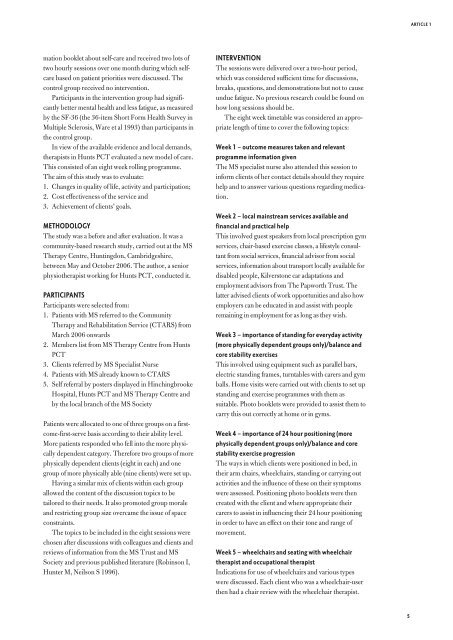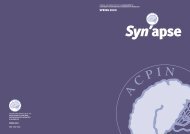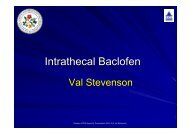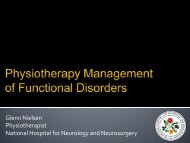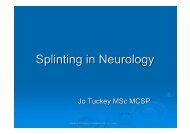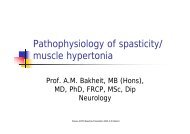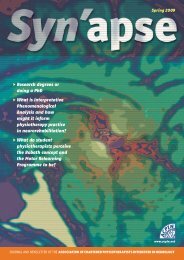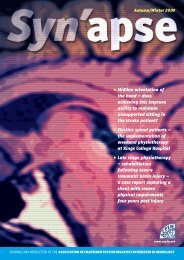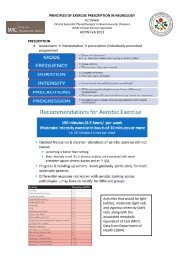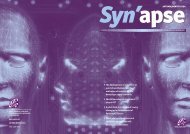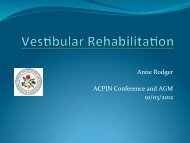SYNAPSE Spring 2007:SYNAPSE - acpin
SYNAPSE Spring 2007:SYNAPSE - acpin
SYNAPSE Spring 2007:SYNAPSE - acpin
Create successful ePaper yourself
Turn your PDF publications into a flip-book with our unique Google optimized e-Paper software.
ARTICLE 1<br />
mation booklet about self-care and received two lots of<br />
two hourly sessions over one month during which selfcare<br />
based on patient priorities were discussed. The<br />
control group received no intervention.<br />
Participants in the intervention group had significantly<br />
better mental health and less fatigue, as measured<br />
by the SF-36 (the 36-item Short Form Health Survey in<br />
Multiple Sclerosis, Ware et al 1993) than participants in<br />
the control group.<br />
In view of the available evidence and local demands,<br />
therapists in Hunts PCT evaluated a new model of care.<br />
This consisted of an eight week rolling programme.<br />
The aim of this study was to evaluate:<br />
1. Changes in quality of life, activity and participation;<br />
2. Cost effectiveness of the service and<br />
3. Achievement of clients’ goals.<br />
METHODOLOGY<br />
The study was a before and after evaluation. It was a<br />
community-based research study, carried out at the MS<br />
Therapy Centre, Huntingdon, Cambridgeshire,<br />
between May and October 2006. The author, a senior<br />
physiotherapist working for Hunts PCT, conducted it.<br />
PARTICIPANTS<br />
Participants were selected from:<br />
1. Patients with MS referred to the Community<br />
Therapy and Rehabilitation Service (CTARS) from<br />
March 2006 onwards<br />
2. Members list from MS Therapy Centre from Hunts<br />
PCT<br />
3. Clients referred by MS Specialist Nurse<br />
4. Patients with MS already known to CTARS<br />
5. Self referral by posters displayed in Hinchingbrooke<br />
Hospital, Hunts PCT and MS Therapy Centre and<br />
by the local branch of the MS Society<br />
Patients were allocated to one of three groups on a firstcome-first-serve<br />
basis according to their ability level.<br />
More patients responded who fell into the more physically<br />
dependent category. Therefore two groups of more<br />
physically dependent clients (eight in each) and one<br />
group of more physically able (nine clients) were set up.<br />
Having a similar mix of clients within each group<br />
allowed the content of the discussion topics to be<br />
tailored to their needs. It also promoted group morale<br />
and restricting group size overcame the issue of space<br />
constraints.<br />
The topics to be included in the eight sessions were<br />
chosen after discussions with colleagues and clients and<br />
reviews of information from the MS Trust and MS<br />
Society and previous published literature (Robinson I,<br />
Hunter M, Neilson S 1996).<br />
INTERVENTION<br />
The sessions were delivered over a two-hour period,<br />
which was considered sufficient time for discussions,<br />
breaks, questions, and demonstrations but not to cause<br />
undue fatigue. No previous research could be found on<br />
how long sessions should be.<br />
The eight week timetable was considered an appropriate<br />
length of time to cover the following topics:<br />
Week 1 – outcome measures taken and relevant<br />
programme information given<br />
The MS specialist nurse also attended this session to<br />
inform clients of her contact details should they require<br />
help and to answer various questions regarding medication.<br />
Week 2 – local mainstream services available and<br />
financial and practical help<br />
This involved guest speakers from local prescription gym<br />
services, chair-based exercise classes, a lifestyle consultant<br />
from social services, financial advisor from social<br />
services, information about transport locally available for<br />
disabled people, Kilverstone car adaptations and<br />
employment advisors from The Papworth Trust. The<br />
latter advised clients of work opportunities and also how<br />
employers can be educated in and assist with people<br />
remaining in employment for as long as they wish.<br />
Week 3 – importance of standing for everyday activity<br />
(more physically dependent groups only)/balance and<br />
core stability exercises<br />
This involved using equipment such as parallel bars,<br />
electric standing frames, turntables with carers and gym<br />
balls. Home visits were carried out with clients to set up<br />
standing and exercise programmes with them as<br />
suitable. Photo booklets were provided to assist them to<br />
carry this out correctly at home or in gyms.<br />
Week 4 – importance of 24 hour positioning (more<br />
physically dependent groups only)/balance and core<br />
stability exercise progression<br />
The ways in which clients were positioned in bed, in<br />
their arm chairs, wheelchairs, standing or carrying out<br />
activities and the influence of these on their symptoms<br />
were assessed. Positioning photo booklets were then<br />
created with the client and where appropriate their<br />
carers to assist in influencing their 24 hour positioning<br />
in order to have an effect on their tone and range of<br />
movement.<br />
Week 5 – wheelchairs and seating with wheelchair<br />
therapist and occupational therapist<br />
Indications for use of wheelchairs and various types<br />
were discussed. Each client who was a wheelchair-user<br />
then had a chair review with the wheelchair therapist.<br />
5


